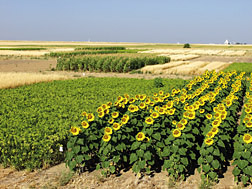This page has been archived and is being provided for reference purposes only. The page is no longer being updated, and therefore, links on the page may be invalid.
|
Read the magazine story to find out more. |
|
|
|
|
Get Into the Zone—the Root Zone
By Laura McGinnisMarch 5, 2007
There's a lot going on beneath the surface. Beyond our sight—but not beyond our control—the futures of farm fields unfold in crop root zones. This area immediately surrounding a plant's roots is the site of physical, chemical and biological activities that govern the plant's growth and its influence on the environment.
To help growers make well-informed decisions, Agricultural Research Service (ARS) scientists in the agency's Agricultural Systems Research Unit at Fort Collins, Colo., created the Root Zone Water Quality Model (RZWQM) in the early 1990s.
Now Fort Collins scientists have developed RZWQM2, an enhanced version of the original water quality model that's been designed to serve an even larger audience with greater ease.
RZWQM2 simulates plant growth and the movement of water, nutrients and chemicals within and around the root zones of agricultural cropping systems. By entering information about their systems, growers can estimate the environmental and economic impacts of a variety of management decisions, including tillage, crop residue management, crop rotations and the timing and rate of chemical applications.
What advantages does the new model have? Research leader Laj Ahuja and his colleagues have linked it to existing crop growth models. A new, user-friendly interface allows input on more components, such as new crop-modeling technology and subsurface drainage. The team also extended the model's application and improved the parameters involved in modeling the flow of shallow groundwater to tile drains, increasing the model's accuracy.
The model has been downloaded more than 1,000 times since it became publicly available in 1995. It is used by researchers and organizations around the world, including the Environmental Protection Agency, the U.S. Geological Survey and the pesticide company Bayer CropScience.
Read more about this research in the March 2007 issue of Agricultural Research magazine.
ARS is the chief in-house scientific research agency of the U.S. Department of Agriculture.

